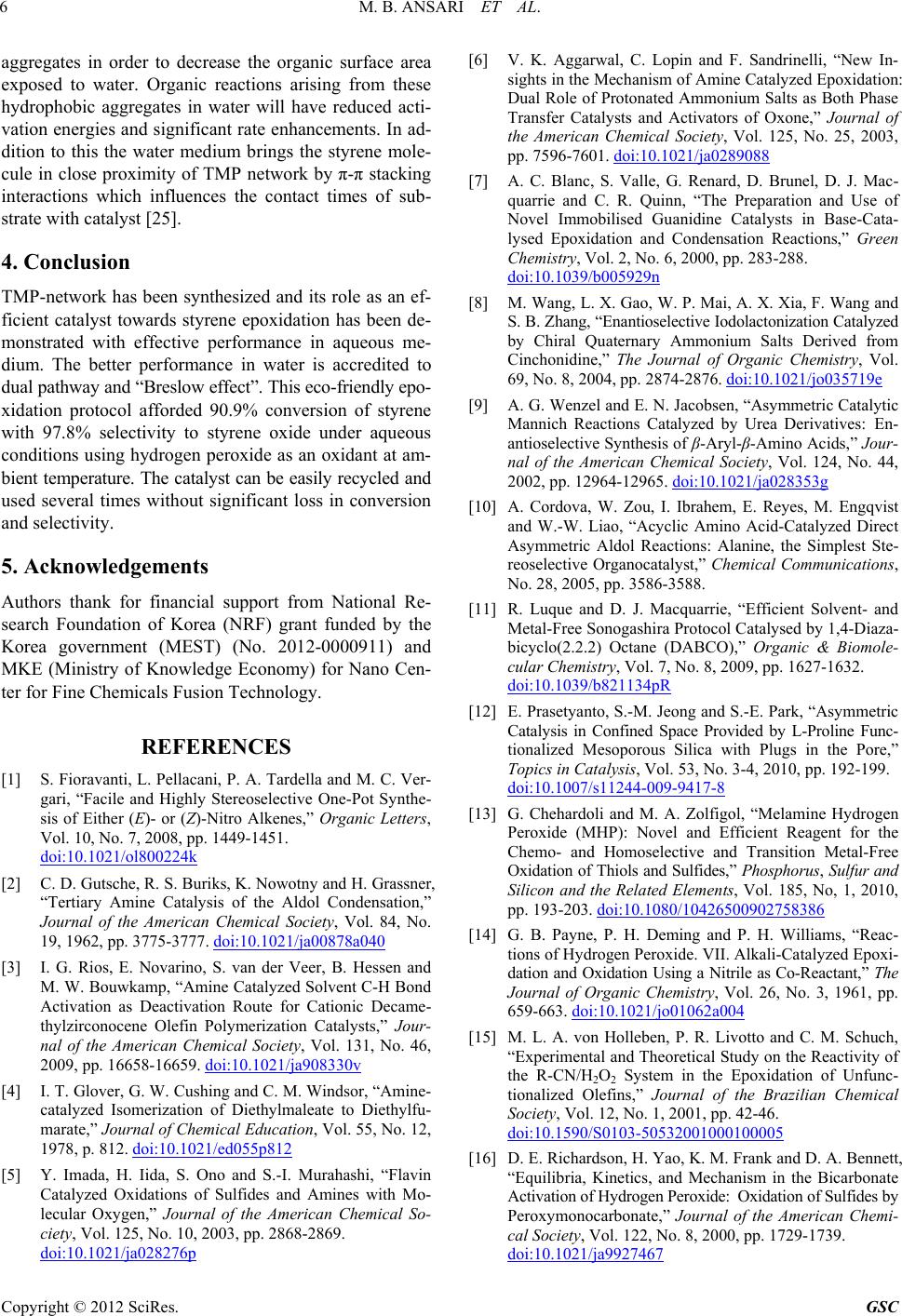
M. B. ANSARI ET AL.
6
aggregates in order to decrease the organic surface area
exposed to water. Organic reactions arising from these
hydrophobic aggregates in water will have reduced acti-
vation energies and significant rate enhancements. In ad-
dition to this the water medium brings the styrene mole-
cule in close proximity of TMP network by π-π stacking
interactions which influences the contact times of sub-
strate with catalyst [25].
4. Conclusion
TMP-network has been synthesized and its role as an ef-
ficient catalyst towards styrene epoxidation has been de-
monstrated with effective performance in aqueous me-
dium. The better performance in water is accredited to
dual pathway and “Breslow effect”. This eco-friendly epo-
xidation protocol afforded 90.9% conversion of styrene
with 97.8% selectivity to styrene oxide under aqueous
conditions using hydrogen peroxide as an oxidant at am-
bient temperature. The catalyst can be easily recycled and
used several times without significant loss in conversion
and selectivity.
5. Acknowledgements
Authors thank for financial support from National Re-
search Foundation of Korea (NRF) grant funded by the
Korea government (MEST) (No. 2012-0000911) and
MKE (Ministry of Knowledge Economy) for Nano Cen-
ter for Fine Chemicals Fusion Technology.
REFERENCES
[1] S. Fioravanti, L. Pellacani, P. A. Tardella and M. C. Ver-
gari, “Facile and Highly Stereoselective One-Pot Synthe-
sis of Either (E)- or (Z)-Nitro Alkenes,” Organic Letters,
Vol. 10, No. 7, 2008, pp. 1449-1451.
doi:10.1021/ol800224k
[2] C. D. Gutsche, R. S. Buriks, K. Nowotny and H. Grassner,
“Tertiary Amine Catalysis of the Aldol Condensation,”
Journal of the American Chemical Society, Vol. 84, No.
19, 1962, pp. 3775-3777. doi:10.1021/ja00878a040
[3] I. G. Rios, E. Novarino, S. van der Veer, B. Hessen and
M. W. Bouwkamp, “Amine Catalyzed Solvent C-H Bond
Activation as Deactivation Route for Cationic Decame-
thylzirconocene Olefin Polymerization Catalysts,” Jour-
nal of the American Chemical Society, Vol. 131, No. 46,
2009, pp. 16658-16659. doi:10.1021/ja908330v
[4] I. T. Glover, G. W. Cushing and C. M. Windsor, “Amine-
catalyzed Isomerization of Diethylmaleate to Diethylfu-
marate,” Journal of Chemical Education, Vol. 55, No. 12,
1978, p. 812. doi:10.1021/ed055p812
[5] Y. Imada, H. Iida, S. Ono and S.-I. Murahashi, “Flavin
Catalyzed Oxidations of Sulfides and Amines with Mo-
lecular Oxygen,” Journal of the American Chemical So-
ciety, Vol. 125, No. 10, 2003, pp. 2868-2869.
doi:10.1021/ja028276p
[6] V. K. Aggarwal, C. Lopin and F. Sandrinelli, “New In-
sights in the Mechanism of Amine Catalyzed Epoxidation:
Dual Role of Protonated Ammonium Salts as Both Phase
Transfer Catalysts and Activators of Oxone,” Journal of
the American Chemical Society, Vol. 125, No. 25, 2003,
pp. 7596-7601. doi:10.1021/ja0289088
[7] A. C. Blanc, S. Valle, G. Renard, D. Brunel, D. J. Mac-
quarrie and C. R. Quinn, “The Preparation and Use of
Novel Immobilised Guanidine Catalysts in Base-Cata-
lysed Epoxidation and Condensation Reactions,” Green
Chemistry, Vol. 2, No. 6, 2000, pp. 283-288.
doi:10.1039/b005929n
[8] M. Wang, L. X. Gao, W. P. Mai, A. X. Xia, F. Wang and
S. B. Zhang, “Enantioselective Iodolactonization Catalyzed
by Chiral Quaternary Ammonium Salts Derived from
Cinchonidine,” The Journal of Organic Chemistry, Vol.
69, No. 8, 2004, pp. 2874-2876. doi:10.1021/jo035719e
[9] A. G. Wenzel and E. N. Jacobsen, “Asymmetric Catalytic
Mannich Reactions Catalyzed by Urea Derivatives: En-
antioselective Synthesis of β-Aryl-β-Amino Acids,” Jour-
nal of the American Chemical Society, Vol. 124, No. 44,
2002, pp. 12964-12965. doi:10.1021/ja028353g
[10] A. Cordova, W. Zou, I. Ibrahem, E. Reyes, M. Engqvist
and W.-W. Liao, “Acyclic Amino Acid-Catalyzed Direct
Asymmetric Aldol Reactions: Alanine, the Simplest Ste-
reoselective Organocatalyst,” Chemical Communications,
No. 28, 2005, pp. 3586-3588.
[11] R. Luque and D. J. Macquarrie, “Efficient Solvent- and
Metal-Free Sonogashira Protocol Catalysed by 1,4-Diaza-
bicyclo(2.2.2) Octane (DABCO),” Organic & Biomole-
cular Chemistry, Vol. 7, No. 8, 2009, pp. 1627-1632.
doi:10.1039/b821134pR
[12] E. Prasetyanto, S.-M. Jeong and S.-E. Park, “Asymmetric
Catalysis in Confined Space Provided by L-Proline Func-
tionalized Mesoporous Silica with Plugs in the Pore,”
Topics in Catalysis, Vol. 53, No. 3-4, 2010, pp. 192-199.
doi:10.1007/s11244-009-9417-8
[13] G. Chehardoli and M. A. Zolfigol, “Melamine Hydrogen
Peroxide (MHP): Novel and Efficient Reagent for the
Chemo- and Homoselective and Transition Metal-Free
Oxidation of Thiols and Sulfides,” Phosphorus, Sulfur and
Silicon and the Related Elements, Vol. 185, No, 1, 2010,
pp. 193-203. doi:10.1080/10426500902758386
[14] G. B. Payne, P. H. Deming and P. H. Williams, “Reac-
tions of Hydrogen Peroxide. VII. Alkali-Catalyzed Epoxi-
dation and Oxidation Using a Nitrile as Co-Reactant,” The
Journal of Organic Chemistry, Vol. 26, No. 3, 1961, pp.
659-663. doi:10.1021/jo01062a004
[15] M. L. A. von Holleben, P. R. Livotto and C. M. Schuch,
“Experimental and Theoretical Study on the Reactivity of
the R-CN/H2O2 System in the Epoxidation of Unfunc-
tionalized Olefins,” Journal of the Brazilian Chemical
Society, Vol. 12, No. 1, 2001, pp. 42-46.
doi:10.1590/S0103-50532001000100005
[16] D. E. Richardson, H. Yao, K. M. Frank and D. A. Bennett,
“Equilibria, Kinetics, and Mechanism in the Bicarbonate
Activation of Hydrogen Peroxide: Oxidation of Sulfides by
Peroxymonocarbonate,” Journal of the American Chemi-
cal Society, Vol. 122, No. 8, 2000, pp. 1729-1739.
doi:10.1021/ja9927467
Copyright © 2012 SciRes. GSC